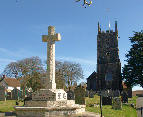A full account of the history of the 1st/6th Devons in India and Mesopotamia can be read on this site in the story of Thomas Knight, who died on March 8th 1916 at Dujailah, together with 9 officers and 43 other men killed or missing and 8 officers and 181 men wounded. For the survivors, the march back to the wadi carrying their wounded on their backs or on spring-less carts was very depressing. The loss of officers was particularly acute: less burdened in the battle than the men, they had run ahead of their companies in the attack and had been the first to have been mown down by Turkish fire. The men were completely exhausted, having been in action for some twenty-one hours, with only their water bottles to quench their thirst and carrying fifty-six pounds of equipment.
The next three weeks were spent at the wadi, trying to increase the bunds to prevent the Tigris from inundating the whole area. On March 31st the whole 36th Brigade moved to Orah in Corps reserve. On April 6th when the 13th Division attacked the Hannah and Falahiyah positions, in a last desperate attempt to relieve Kut, the 1st/6th was involved only by giving covering machine-gun fire from the right bank. After this the Battalion took over some captured trenches at Beit Aiessa, and then on 21st April gave support to the Meerut Division in the last (and failed) attack on Sannaiyat, before moving back to Abu Rahman on the day that Kut finally surrendered, April 29th.
In May 1916 the whole Mesopotamia Force was reorganized; the 1st/6th left the 36th Brigade for the Line of Communications, guarding and defending from marauding Arabs key points that led upstream from Basra. Fresh drafts were received from the 2nd/6th in May, June and July, but sickness and exhaustion had taken their toll. Only 7 officers and 180 men remained reasonably fit for guard duties requiring 147 men each night. On August 13th a burial party visited the battle site of Dujailah; 20 bodies were buried and identifications secured. In September the Battalion moved to Sheik Saad, and in October to Amara at which time it totaled only 9 officers and 276 other ranks. By February 1917 new drafts had brought the Battalion up to over 950 strong. The Battalion’s task was now to protect the light railway that ran from Sheik Saad to the Shatt al Hai. Here they stayed well away from General Maud’s campaign to advance to Baghdad and beyond, protecting the railway and collecting battlefield salvage, and having occasional brushes with Arab marauders. In April 1917 there was a move to Shaiba on the Euphrates, west of Basra, with many personnel moving to India to recover from sickness, or for periods of leave. Life was far from comfortable, however, with temperatures in July and August reaching a maximum of 124 degrees.
The end of the war in November 1918 saw the 1st/6th at Magil Camp, Basra, recovering from the attacks of the Spanish influenza epidemic which had been raging since October. Later in November the Battalion moved back to Shaiba, where 200 men and one officer were dispatched to Salonika. On 6th December the remainder moved up-stream to Amara, where demobilization began.
Of great interest in Winkleigh was the order in which men were demobilized. Before the New Year only schoolmasters and students were released but in January 1919 married men with four years overseas went first, then coal-miners and men over 41. There were in fact 371 men with the Battalion who had had four years overseas since August 4th 1914, and three officers and 110 men with three years. On March 30th the remainder of the Battalion left for Karachi, but disappointment followed, as the Battalion was expected to be reinforced and dispatched for duty on the North-West frontier against Afghan tribes who had broken out in revolt. In the end the duty was canceled but not before the men had endured a hot and weary summer, and did not finally leave Bombay until July 27th reaching Plymouth on August 16th. On the 19th they reached Barnstaple to be given a warm reception at the Guildhall attended by the Lord Lieutenant, the Mayor and Town Council, before its members dispersed to their homes.


